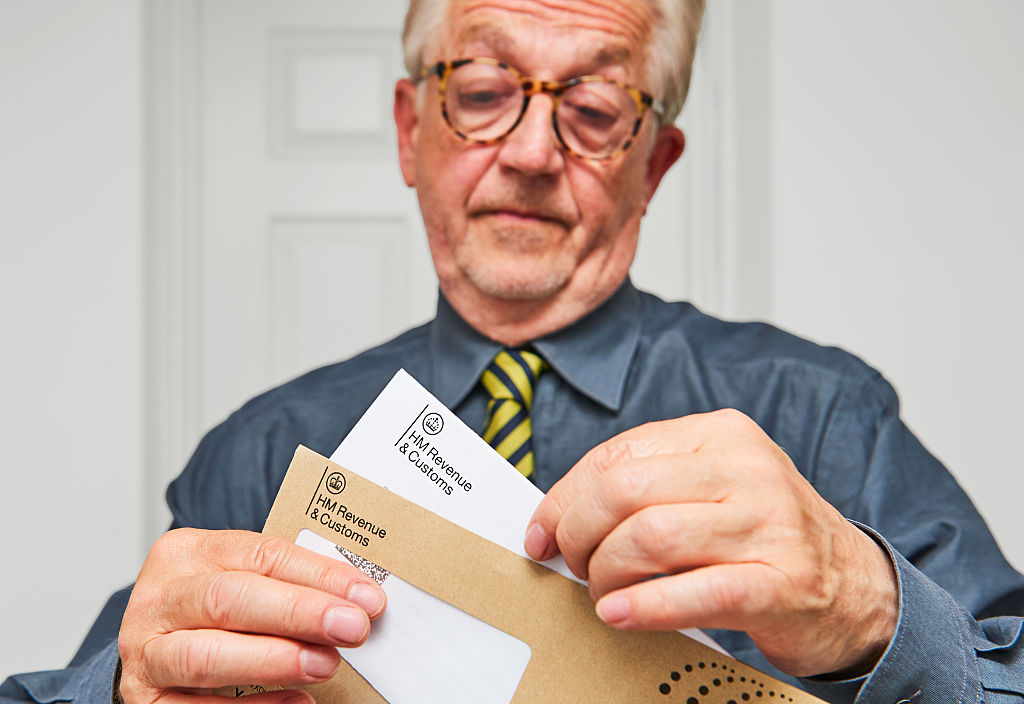How income tax is calculated
Millions of taxpayers face paying more income tax due to frozen tax allowances. We explain how income tax is calculated.
Sam Walker

Income tax is charged on most types of income but tax allowances protect some from the taxman.
If you earn money from a job, you will have to pay tax once you breach the tax-free allowance. If you get pension income and/or interest earned on savings, they could be subject to income tax too.
Income tax is used by the government to fund public services such as the NHS, schools and prisons, as well as to pay off debt.
MoneyWeek
Subscribe to MoneyWeek today and get your first six magazine issues absolutely FREE

Sign up to Money Morning
Don't miss the latest investment and personal finances news, market analysis, plus money-saving tips with our free twice-daily newsletter
Don't miss the latest investment and personal finances news, market analysis, plus money-saving tips with our free twice-daily newsletter
The government is expected to earn £359 billion in income tax in the 2026/27 financial year, according to the Office for Budget Responsibility (OBR), accounting for more than a quarter of total tax revenue.
The number of people having to pay higher amounts of tax is on the rise due to rising wages, inflation and frozen thresholds.
Meanwhile, some income tax changes are set to take effect over the coming years which will have an impact on your finances.
For example, tax rates on income from dividends will increase from April 2026.
We explain everything you need to know about income tax below, how much you pay, and a legal route you can take to pay less.
What income tax will I pay?
Income tax is calculated on your earnings — employed or self-employed — in tiers. Essentially, the more you earn, the more tax you pay. It differs, however, depending on where in the country you live.
Income tax is calculated on your earnings – employed or self-employed – in tiers. Essentially, the more you earn, the more tax you pay. It differs, however, depending on where in the country you live.
Earnings are tax-free up to £12,570. This figure is known as the personal allowance.
After that, in England, Wales and Northern Ireland, you’ll pay what’s known as the basic rate of tax which is 20% on earnings between £12,571 and £50,270.
For earnings of £50,271 and £125,140 you’ll pay a higher rate of tax at 40%.
An additional rate of 45% is applied to earnings over £125,140.
Income tax band | Taxable income | Tax rate |
|---|---|---|
Personal allowance | Up to £12,570 | 0% |
Basic rate | £12,571 to £50,270 | 20% |
Higher rate | £50,271 to £125,140 | 40% |
Additional rate | Over £125,140 | 45% |
Income tax rates in Scotland
If you live in Scotland the way that income tax is calculated is slightly different.
Everyone still has a £12,570 personal allowance. Then there are tiers. The starter rate of 19% is applied to earnings between £12,571 and £15,397.
Income tax band | Taxable income | Scottish tax rate |
|---|---|---|
Personal allowance | Up to £12,570 | 0% |
Starter rate | £12,571 to £15,397 | 19% |
Basic rate | £15,398 to £27,491 | 20% |
Intermediate rate | £27,492 to £43,662 | 21% |
Higher rate | £43,663 to £75,000 | 42% |
Advanced rate | £75,001 to £125,140 | 45% |
Top rate | Over £125,140 | 48% |
What is the personal allowance?
The personal allowance – currently £12,570 – is the amount of earnings you can receive without paying any income tax at all.
When do you lose your personal allowance?
The personal allowance is the amount you can earn each year before paying income tax. However, when your earnings reach a certain level, you start to lose that allowance.
HM Revenue & Customs (HMRC) rules state that for every £2 you earn over £100,000 per annum, you lose £1 worth of your £12,570 tax-free personal allowance. Those who earn an income above £125,140 will have no personal allowance at all.
This rule effectively creates an income tax band of 60% for the portion of your earnings between £100,000 and £125,140.
As an example, let’s say an individual earns a salary of £100,000, and they receive a bonus of £20,000 giving a total of £120,000.
From this bonus, the higher rate of 40% is payable, which means that £8,000 would be deducted.
Since the bonus tips the numbers over the £100,000 threshold, there is the reduction to the personal allowance in this instance of £10,000, which also means there is an additional £10,000 brought into the higher rate income tax bracket.
This results in a further £4,000 of income tax being due, equivalent to a 60% tax rate.
Hundreds of thousands more people are set to be dragged into the so-called ‘60% tax trap’ by 2028/29, recent analysis by wealth management firm Rathbones suggests.
Do dividends count towards the personal allowance?
Dividends are taxable – unless investments that generate dividends are held in an ISA – over and above an annual allowance. You don’t pay any tax on any dividend income that falls within your personal allowance and there’s also a separate annual dividend allowance of £500 per person.
So, if you received £13,070 in dividend income in the 2025/26 tax year, the first £12,570 could be covered by the personal allowance, and the remaining £500 by the dividend allowance.
Dividend tax over and above allowances (and outside an ISA) is charged at special rates according to the highest rate of income tax you pay.
The rate applied to dividend income for basic rate taxpayers is 8.75%. If the taxable dividend income tipped into the higher rate tax band, the rate of tax applied would be 33.75%, and for additional rate taxpayers, 39.35% tax rate would apply.
As confirmed in the 2025 Budget, some dividend tax rates will rise by two percentage points from April 2026. The basic rate will increase to 10.75%, and the higher rate to 35.75%. The additional rate is remaining at 39.35%.
Does the personal allowance apply to capital gains?
The personal allowance does not apply to capital gains. Individuals have a separate annual capital gains tax exemption of £3,000 per person, per tax year.
If the total of all gains and losses in the tax year fall within this amount you don’t need to pay any tax.
Do savings count towards the personal allowance?
The amount of money held in savings does not directly impact your personal allowance for income tax. But you might have to pay income tax on interest received from savings.
The annual personal savings allowance (PSA) means basic rate taxpayers can earn £1,000 of tax-free interest every tax year, after which they pay 20% on any interest earned above the threshold.
If you’re a higher rate taxpayer this allowance drops to £500 a year and after that your income from savings is taxed at 40%.
Top rate taxpayers don’t have a PSA so will pay 45% on interest from savings.
For example, a basic rate taxpayer with £8,000 saved in a taxable savings account paying 4.35% interest would not have to pay income tax on any interest earned in the 2025/26 year, if no more money was added to the account over the 12 month period. The total interest earned would be £359, based on the interest rate of 4.35% staying the same for the whole year, which is well below the basic rate PSA of £1,000.
Any interest you earn over your PSA is paid at your marginal tax rate. So, basic rate taxpayers pay 20% on any interest earned over the £1,000 PSA.
Savings income tax rates are rising by two percentage points from April 2027. The basic rate will rise from 20% to 22%, the higher rate from 40% to 42% and the additional rate from 45% to 47%.
What is the marriage allowance?
The marriage allowance is a mechanism to allow married couples and those in civil partnerships to transfer 10% of their personal allowance to the other, who can then claim the value of that allowance.
This means £1,260 of your personal allowance can be transferred to your spouse or civil partner if they earn more than you. However, there are eligibility rules to apply.
Who can apply for the marriage allowance?
You must be married or in a civil partnership and one of you must be a non-taxpayer and one must be a basic-rate taxpayer. Higher or additional-rate taxpayers aren't eligible for this allowance.
The marriage allowance could reduce a tax bill by up to £252. It is also worth checking if you are eligible to backdate your claim, as in some cases you may be eligible to claim from tax years since 6 April 2021 (the 2021/22 tax year).
To be eligible for the marriage allowance in Scotland, your partner must pay the starter, basic or intermediate rate, which usually means their income is between £12,571 and £43,662.
How to transfer the personal allowance
The quickest way to apply for marriage allowance is online. You’ll need your National Insurance number and your partner’s National Insurance number.
There is also the option to apply by post, completing a MATCF form –– available on gov.uk.
You can also opt to do it through a self-assessment tax return if you’re already registered and file tax returns anyway.
Are income tax rates going up in 2026?
There are no planned changes to income tax rates in 2026. Usually, it would be expected that the income tax band thresholds would rise to reflect the increased cost of living, allowing workers to earn more money before higher tax rates kick in.
However, they have been frozen since 2021, and the personal tax-free allowance of £12,570 and other tax bands will be frozen up to and including the 2030/31 tax year.
The freeze was originally planned to end in April 2028, but was extended by a further three years in the 2025 Budget.
However, the policy of not increasing allowances in line with the cost of living forces millions of earners to pay more tax as wages go up through a phenomenon known as fiscal drag.
It is known as a stealth tax because workers end up paying more tax as their salaries rise — without the government increasing headline tax rates.
Income tax if you’re self-employed
Do I need to fill in a self-assessment tax return?
If you’re self-employed you will need to complete an annual self-assessment tax return which will calculate the amount of income tax you need to pay – unlike employed people who automatically pay tax through the PAYE (Pay As You Earn) system.
You can file your own self-assessment tax return or enlist the help of an accountant to do it on your behalf. It’s important to have a keen understanding of what you will owe to ensure you keep enough back to cover the bill.
Be careful to note the self-assessment tax return deadlines to avoid penalties.
National Insurance
National Insurance is a tax on earnings paid by both employees and employers; the self-employed pay it on their profits. It’s used to pay for the NHS, benefits such as maternity pay, and the state pension.
The rates of NI are different for employed and self-employed people.
For those employed, you pay class 1 National Insurance contributions and the levels are tiered according to your earnings. No NI is due if you earn £0-£242 a week. You pay 8% on earnings between £242.01 and £967 and then 2% on those who earn over £967 a week.
The self-employed pay class 4 NI which is 6% on profits of £12,570 up to £50,270 and 2% on profits over £50,270.
Your NI contributions will be on your self-assessment tax return and are due at the same time as income tax.
You do not pay NI once you reach the state pension age. Though if you are self-employed you stop paying class 4 NI from the start of the tax year after the one in which you reach state pension age.
Get the latest financial news, insights and expert analysis from our award-winning MoneyWeek team, to help you understand what really matters when it comes to your finances.
Holly Thomas is a freelance financial journalist covering personal finance and investments.
She has written for a number of papers, including The Times, The Sunday Times and the Daily Mail.
Previously she worked as deputy personal finance editor at The Sunday Times, Money Editor at the Daily/Sunday Express and also at Financial Times Business.
She has won Investment Freelance Journalist of the Year at the Aegon Asset Management Media Awards in November 2021.
- Sam WalkerStaff Writer
-
 ‘Why I have ditched my Help to Buy ISA for cash savings and the stock market’
‘Why I have ditched my Help to Buy ISA for cash savings and the stock market’Without the 25% bonus, my Help to Buy ISA is effectively redundant, says MoneyWeek writer Sam Walker.
-
 Is your inheritance tax allowance cut if you sell to downsize or sell your home to pay for care?
Is your inheritance tax allowance cut if you sell to downsize or sell your home to pay for care?Downsizing relief is a little-known benefit that could save your loved ones tens of thousands of pounds in inheritance tax after you’ve died.